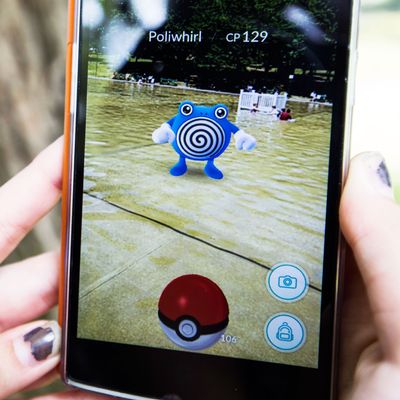
If you’re anything like me, this weekend you sold all of your worldly possessions, said good-bye to your family, and headed west in search of Pokémon. From the hills of Appalachia to the waves of Malibu, phone-wielding Americans have succumbed to an epidemic of Pokémon Go, the augmented-reality smartphone game that lets you catch Pokémon’s fictional little monsters in real-life locations.
There are still many unanswered questions, such as “How do you play Pokémon Go?” “Should I break up with my boyfriend if he leaves dinner to catch a Squirtle?” and “Where can I find a legendary?” Far beyond, and much less important than those questions, is how the hell a janky, barely working children’s video game has suddenly become the most talked-about app since Snapchat.
“Janky” is really the only way to describe it. For the first few days, the game was rarely accessible, as its servers kept going down; over the weekend, users were forced to log in over and over again; even now, it freezes and locks up constantly. The gameplay itself can be fun — look, Pokémon in real life! — but in most ways it’s just another smartphone game: You wait, you swipe, you grind out levels. Put another way, there’s very little from the actual experience of using the app that would indicate that it was destined to become an enormous success. Even to the developer, Niantic, which has struggled to keep up with demand. And, indeed, before Go, Niantic made a near-identical game, Ingress, which was popular but never quite broke into the mainstream.
So what gives? One thing Pokémon Go has going for it is — to put it scientifically — a metric buttload of nostalgia. Despite the app’s infrastructural problems, Niantic has done a great job of creating the “experience” of spotting and catching Pokémon as envisioned by millions of adolescents watching the cartoon or playing the earlier games. And, well, those cartoons and games are the product of a 20-year-old marketing juggernaut that turned Pokémon into an international empire in which anyone under the age of 30 has spent time. Maybe most important, it has a large group of former fans who game more often on their phones than on Game Boys. (If you don’t believe me, Vox’s Alvin Chang has the data to back this up.)
That nostalgia creates a built-in audience eager for an IRL Pokémon experience. And it’s here that Pokémon Go is most interesting. Go represents the most widely adopted example yet of augmented reality, a much-hyped technology that uses phones and other viewers to add a layer of computer-generated imagery and information on top of the world around you. While AR (and its cousin VR) are in early stages, it can be hard to get a sense of what they’d look like and how they’d be used when adopted widely. By launching with an already-enormous audience, Pokémon Go gives us a glimpse of what mass adoption of augmented reality looks like in practice.
Among other things, it helps demonstrate the important distinction between VR and AR, which is often just considered a half-step toward the full experience of virtual reality. With VR, you put on a headset that essentially blocks out the world. There are merits to this type of full immersion and simulation, but you have to carry those experiences back with you into the real world. VR, while in use, is pure escapism. AR, on the other hand, combines with the tangible, piggybacking onto the real world and giving you new ways to interact with it directly.
And well, the other thing is: Pokémon Go makes the augmented-reality future actually look … really fun. For all the complaints about zombies lumbering around public parks, Go is a surprisingly social experience. It’s hard to play it, out in the world, without running into fellow players — striking up conversations, exchanging tips and directions, and generally laughing about how goofy it is to meet and interact with new people thanks to a Pokémon game.
This is a striking departure from the virtual-reality dystopias envisioned by skeptics — people sitting slack-jawed on their couches, jacked into a fantasy world better than the real one. It’s true that virtual reality has enormous potential to create social experiences. But it’s hard to imagine, barring several enormous technological leaps, a virtual-reality social interaction that beats in-person conversation. (Ultima Online designer Raph Koster puts it in gaming jargon: “Pokémon GO has the best emote system available: the human body.”) For VR to work, it needs to be flawless, but for AR to really work, it just needs to be good enough. And that’s what Go is. It’s certainly not a great game, or even addictive one.
But as a way to look at the world, or to meet and interact with people, it’s great. The Pokémon Go utopia is active and social, and uses technology as a way to enhance — or, at the very least, alter — one’s interaction with the physical world, rather than close oneself off from it. Weirdly enough, people staring at their phones at public parks might end up being the best argument we have against Luddites who claim that technology is cutting people off from each other.





























